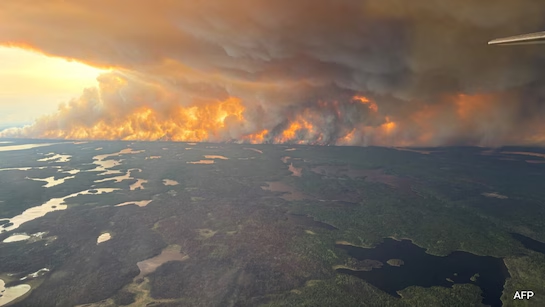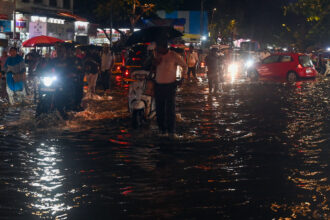Introduction
Wildfires raging across Western Canada have escalated into a Western Canada wildfires, widespread emergency, forcing thousands of residents to evacuate from their homes. The provinces of Saskatchewan and Manitoba are particularly hard hit, with dozens of wildfires burning uncontrollably in extreme conditions. This wildfire crisis underscores the growing threat posed by climate change to Canada’s environment and communities.
Current Wildfire Situation in Canada

As of May 2025, more than 166 wildfires are active nationwide, with 84 declared “out of control” by the Canadian Interagency Forest Fire Centre. Saskatchewan is battling 14 major wildfires, prompting Premier Scott Moe to declare a state of emergency. Manitoba has already evacuated 17,000 people and also declared an emergency, while Alberta, Ontario, and British Columbia report significant wildfire activity.
The Canadian Armed Forces have been deployed to Manitoba to assist with evacuation logistics and firefighting efforts, emphasizing the scale and severity of the crisis.
Human Impact and Evacuations
The human toll of this wildfire emergency is deeply felt. Tragically, a couple recently lost their lives near Winnipeg after being trapped by rapidly spreading flames. Thousands have fled to community shelters, sports venues, and emergency centers, often under urgent and chaotic circumstances. Residents in evacuation zones describe surreal scenes as entire towns drive away in convoys to escape the advancing fires Western Canada wildfires,.
Smoke from the wildfires has crossed into the United States, affecting air quality in major cities such as Minneapolis, Detroit, and Chicago. Authorities have issued air quality alerts in these regions, highlighting the wildfire’s broader environmental impact.
Climate Change and the Increasing Severity of Wildfires
Scientists widely agree that climate change is intensifying wildfire seasons in Canada. The country is warming at twice the global average rate, with its Arctic regions warming three times faster. These changes lead to drier, hotter conditions that promote the spread and severity of wildfires. For more details on the links between climate change and wildfires, visit the EPA’s climate indicators on wildfires.

What’s Being Done and What Comes Next?
- The Canadian government continues to deploy resources, including military support, to affected provinces.
- Emergency services are working tirelessly to assist evacuees and contain the fires.
- Authorities urge residents in vulnerable areas to prepare for potential evacuation orders.
This wildfire emergency is a stark reminder of the urgent need to address climate change and improve disaster preparedness nationwide.
Conclusion
The 2025 Western Canada wildfires represent one of the most severe wildfire crises in recent history. With thousands displaced and large areas devastated, the event highlights how climate change is reshaping natural disasters globally. Staying informed, following evacuation orders, and supporting climate action are critical steps forward.
Stay updated on wildfire developments and learn how you can prepare for emergencies on our Disaster & Emergency page.









